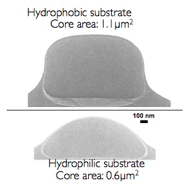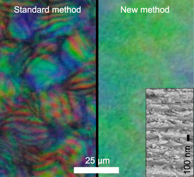Liquid Crystalline Soft Matter
Self-assembly and self-organization
Central themes in our research are self-assembly and self-organization. These terms are used for a wide range of phenomena in which ordered structures form spontaneously, for instance by bringing a sufficient concentration of molecules with contrasting functionalities into solution. A classic example is the formation of micelles and long-range ordered liquid crystalline structures by amphiphiles or surfactants in water, a process that we use frequently in our work. Also thermotropic liquid crystal molecules (the type you find in the flat panel displays of your computer, mobile phone etc.) self-organize into a variety of structures, which one depending on the structural details of the molecule, the temperature, the surfaces in contact with the liquid crystal, as well as on electric or magnetic fields or mechanical stresses that may be applied to the sample. A highly useful and extremely important type of self-assembly is that of single-stranded DNA chains forming duplexes with complementary strands, thereby building a double helix structure. This is not only a key component of life but it has been used in very elegant ways recently in synthetic nanotechnology.
Some good introductory or illustrative articles on self-assembly (more general in nature than the publications of our group) are for instance the following:
- George Whitesides and Bartosz Grzybowski, “Self-Assembly at All Scales”, Science, 295, 5564, pp. 2418-2421 (2002)
- Geoffrey A. Ozin, Kun Hou, Bettina V. Lotsch, Ludovico Cademartiri, Daniel P. Puzzo, Francesco Scotognella, Arya Ghadimi and Jordan Thomson “Nanofabrication by self-assembly”, Materials Today, 12, 5, pp. 12.23 (2009)
- Michi Nakata, Giuliano Zanchetta, Brandon D. Chapman, Christopher D. Jones, Julie O. Cross, Ronald Pindak, Tommaso Bellini, Noel A. Clark, “End-to-end stacking and liquid crystal condensation of 6 to 20 base pair DNA duplexes”, Science, 318, 5854, pp. 1276-1279 (2007)
- Nadrian C. Seeman, “Nanotechnology and the Double Helix”, Scientific American, 290, 6, pp. 65-75 (2004)
- Paul W. K. Rothemund, “Folding DNA to create nanoscale shapes and patterns”, Nature, 440, 7082, pp. 297-302 (2006)
 Back to research overview map.
Back to research overview map.


